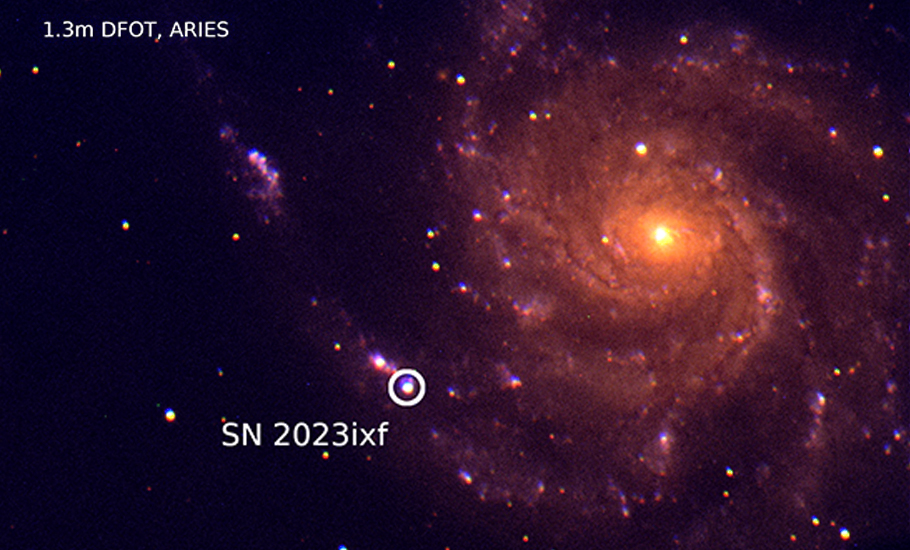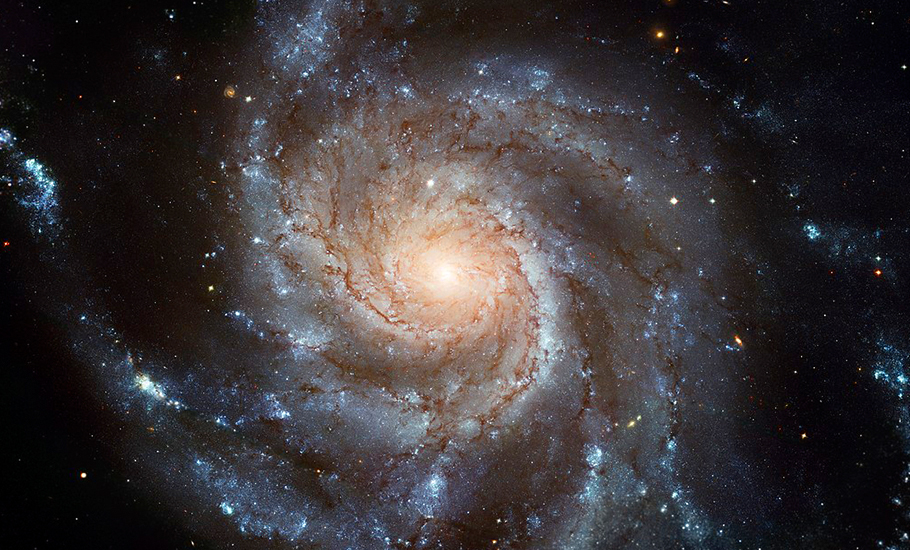
- Home
- News
- Analysis
- States
- Perspective
- Videos
- Education
- Entertainment
- Elections
- World Cup 2023
- Features
- Health
- Business
- Series
- Economy Series
- Earth Day
- Kashmir’s Frozen Turbulence
- India@75
- The legend of Ramjanmabhoomi
- Liberalisation@30
- How to tame a dragon
- Celebrating biodiversity
- Farm Matters
- 50 days of solitude
- Bringing Migrants Home
- Budget 2020
- Jharkhand Votes
- The Federal Investigates
- The Federal Impact
- Vanishing Sand
- Gandhi @ 150
- Andhra Today
- Field report
- Operation Gulmarg
- Pandemic @1 Mn in India
- The Federal Year-End
- The Zero Year
- Premium
- Science
- Brand studio
- Home
- NewsNews
- Analysis
- StatesStates
- PerspectivePerspective
- VideosVideos
- Entertainment
- ElectionsElections
- Sports
- Loading...
Sports - Features
- BusinessBusiness
- Premium
- Loading...
Premium

Why astronomers are racing to observe the violent death of a supergiant star

Astronomers around the world are pointing their telescopes at the Pinwheel Galaxy, located just below the constellation Ursa Major (Saptarishi), to observe a rare celestial fireworks display: the death of a supergiant star in a supernova explosion that shines with the brightness of billions of stars. The dying star, designated SN 2023ixf, was first discovered on May 19, 2023, and is located...
Astronomers around the world are pointing their telescopes at the Pinwheel Galaxy, located just below the constellation Ursa Major (Saptarishi), to observe a rare celestial fireworks display: the death of a supergiant star in a supernova explosion that shines with the brightness of billions of stars. The dying star, designated SN 2023ixf, was first discovered on May 19, 2023, and is located about 21 million light-years from Earth, visible even with a small telescope.
What is a supernova?
Massive stars undergo a cataclysmic explosion at the end of their lives and transform into an exotic neutron star or an enigmatic black hole.
Also Read | Early warning system to alert when a star dies in a supernova explosion
“When the mass of the central core of a supergiant star exceeds the threshold of ‘Chandrasekhar mass’, it collapses into a neutron star or a black hole. The shock waves destroy the star’s envelope, leading to a supernova explosion,” says Dr Kuntal Misra. She works at the Aryabhatta Research Institute of Observational Sciences (ARIES) in Nainital and studies the cosmic explosions that result from the death of stars.
The massive burst would release more energy in a few seconds than a typical star like our sun emits in its billion-year life. A faint, dim sombre star suddenly shines brilliantly and emits colossal energy in the form of light and other electromagnetic waves.
Supernovae are the principal sources of heavy elements in the universe. While elements like carbon, oxygen and iron are cooked inside a star, heavy elements like gold, silver and uranium are synthesised only during the supernova explosion. The debris from the star’s supernova explosion expands out into a nebula, and the basic building blocks of the universe, hydrogen, helium, carbon, gold, and all the elements of the periodic table, are scattered into the interstellar medium as stardust. So the iron in our haemoglobin, the carbon in glucose, the gold in jewellery, and the uranium in nuclear power plants all come from stellar explosions.
Why the are astronomers excited
Amateur and professional astronomers are excited about the find. Researchers believe that in a galaxy the size of the Milky Way, a supernova occurs every 50 years on average, which means that every 10 seconds a star explodes somewhere in the universe.
“Thousands of supernovae are discovered and observed every year, but the most exciting thing about SN 2023ixf is its proximity to us,” says Dr Kuntal Misra.

The supernova is expected to be bright enough to be observed directly for months. Even with a modest telescope, amateur astronomers can spot the spectacular event live.
From a cosmological perspective, the event is closer to our home planet and therefore bright enough for astronomers to pick out details. In addition, the event was detected early on so astronomers can study the different phases of the supernova from the beginning. “Because the event occurred in our immediate vicinity, we will be able to study it extensively in wavelengths ranging from X-rays to radio waves, and this will provide a unique opportunity to test and refine our theories and models about supernovae,” says Dr Kuntal Misra.
The extensive observations being conducted around the world are expected to provide the most detailed picture of how supernovae form and decay. “ARIES telescopes are observing this supernova and my graduate student Naveen Dukiya is leading the observational effort to collect this data,” she says.
For example, researchers use the spectrograph to break down the incoming light into rainbow colours and carefully look for bright and dark lines. Like a fingerprint, these lines are the calling cards of atoms and molecules. With this information, they hope to estimate which and how many elements are released in the different phases of the supernova explosion.
Birth of a neutron star
A supernova can lead to a black hole or a neutron star, depending on the original mass of the progenitor star. According to the researchers, the progenitor star that exploded into a supernova was a red supergiant with a mass of about 10-20 solar masses. “Because the pinwheel galaxy where the event occurred is close to us, we can resolve individual stars on images from powerful space telescopes. Astronomers have identified a candidate progenitor at the location of the supernova whose brightness and colours are consistent with a red supergiant,” said Naveen Dukiya.
Also Read | Why did Chandrayaan-2 fail? Corrections may help ISRO’s next moonshot, says report
When a black hole forms, its extreme gravity pulls back some of the ejected material. As a result, supernova explosions that create a black hole tend to be weaker than those that create a neutron star. From the data collected so far, “this explosion is likely to produce a neutron star,” she says. “However, it’s impossible to say for sure at this point,” he adds.
Who discovered the explosion?
Amateur astronomer Koichi Itagaki of Yamagata, Japan, discovered it with his backyard telescope. The sophisticated Zwicky Transient Facility (ZTF) in California confirmed the discovery next day.
Seventy-five-year-old Itagaki, who was born November 12, 1947, uses his nine telescopes at his home on the slopes of Mount Sao to search the sky daily for new objects. Since 2000, when he took up the hobby, he has discovered more than 172 supernovae, three comets and five minor planets.
Where it is located in the sky
The Pinwheel Galaxy is found near the Big Dipper (Saptarishi) in the night sky. The galaxy is seen at the end of the ‘handle’ of the Big Dipper, near the two stars Mizar (Vasishtha) and Alkaid (Marichi). Its position in the sky is northeast of the point about halfway between these stars. The galaxy is about 21 million light-years from Earth and, with an estimated one trillion stars, is nearly twice the size of our Milky Way Galaxy. With a modest telescope at lower magnification, the exploding star can be identified in the sky for about a month with a wide-angle eyepiece.
The life of a star
Stars shine through a process known as thermonuclear fusion. In the core of the sun, about 600 million tonnes of hydrogen fuses into 596 million tonnes of helium every second. We know that matter is neither created nor destroyed. Therefore, the ‘missing’ 4 million tonnes of mass in nuclear fusion is converted into pure energy using Einstein’s most famous formula, E=mC^2. Most of this energy comes from the Sun in the form of light, heat, radio waves and other forms of electromagnetic waves.
The outward flow of energy must cause the star to expand, but gravity counteracts this and keeps the shape of the star in balance. It is a tug-of-war between gravity, which tries to pack matter toward the centre into as tight a sphere as possible, and the outward pressure of thermal energy from nuclear fusion, which resists the inward squeeze.
The equilibrium is disturbed as soon as the hydrogen in the core is used up and the fusion process comes to a grinding halt. In the absence of thermal energy, gravity briefly gains the upper hand and the core is further compressed. In this superdense state, the pressure becomes so strong that helium fuses into carbon. The star starts to shine again and gets a second lease of life.
Indian-born American astrophysicist Subrahmanyan Chandrasekhar found that for stars like the Sun whose mass is less than 1.44 times the Sun’s mass (called the Chandrasekhar limit), this is the final stage of their life. The repulsive force between the electrons keeps gravity in check, and the star becomes a compact object called a white dwarf, slowly radiating its accumulated thermal energy and cooling over millions of years. Typically, a white dwarf has the mass of the Sun but is only slightly larger than the Earth. The carbon-rich core will gently rearrange into a massive diamond.
Beyond the Chandrasekhar limit
Massive stars whose core mass is above the Chandrasekhar limit, which is 1.44 times the mass of the Sun, have a different life. In massive stars the gravitational pressure can overcome the repulsion between the electrons and even fuse even the carbon, then the neon, then the oxygen all the way to iron This leads to a layered structure, similar to an onion, where each element of the periodic table forms a blanket around the iron-rich core.
The formation of iron in the core is the showstopper. When elements such as hydrogen and oxygen fuse, energy is released; but to fuse iron, energy must be added. So when there is enough iron in the core, the fusion process comes to a grinding halt and gravity takes over. So once an iron-rich nucleus is formed, gravity has the last laugh.
The collapse of the star can no longer be stopped and crumples within the blink of an eye. It explodes with the luminosity of billions of stars. This is a supernova.
The aftermath of celestial fireworks
A star eight to fifty times the mass of the Sun, if it could not be stopped, would collapse to a size of only 20 kilometres, which is about the area of the Chennai Municipal Corporation. The collapse takes place in only 15 seconds.
Like a ball from a concrete floor, the inward-falling outer layer of the star bounces outward from the iron core. This causes violent shock waves that rip through the material around the core. The shock waves are compression waves, meaning that when the outer layer is briefly compressed, elements higher than iron, such as gold, silver, platinum, and uranium, are formed.
The shock waves also cause the emission of an enormous amount of light and electromagnetic waves. The flaming supernova reaches its maximum brightness in about a hundred days, after which the brightness decreases over the next two years. The propagating shock wave can be observed for decades to come through powerful telescopes near the stellar remnant as a colourful nebula.
At the centre, the core would transform into either a neutron star or a black hole, depending on the mass of the progenitor star. If the mass is more than 8 times but less than 20 times the mass of the Sun, a neutron star is formed. A more massive star will produce a black hole.
(Dr TV Venkateswaran is a scientists with Vigyan Prasar, Dept of Science and Technology, New Delhi, and a science communicator and trainer. Views expressed are personal.)

